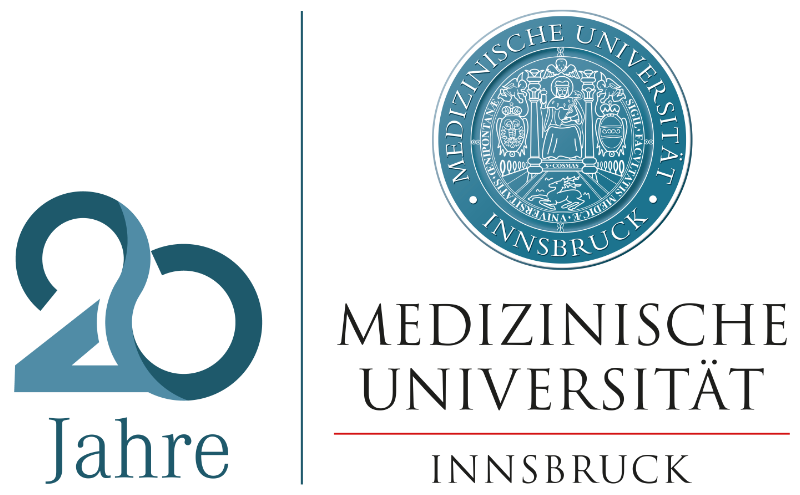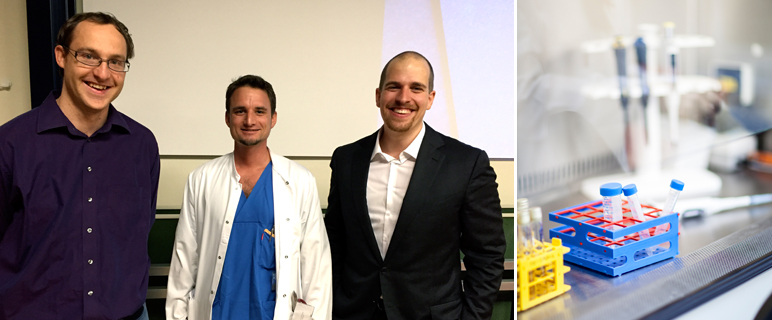Erste erfolgreiche Abschlüsse im Clinical PhD
Im WS 2011/12 startete an der Medizinischen Universität Innsbruck das neue Doktoratsstudium der klinisch-medizinischen Wissenschaften (Clinical PhD) mit elf DoktorandInnen. Die ersten erfolgreichen Abschlüsse von drei Doktoratskandidaten bilden aktuell den Höhepunkt im bisherigen Verlauf dieser in Österreich einzigartigen berufsbegleitenden Doktoratsausbildung.
Der Clinical PhD ermöglicht geeigneten AbsolventInnen der Diplomstudien Humanmedizin und Zahnmedizin eine fundierte und fokussierte wissenschaftliche Ausbildung in derzeit sechs interdisziplinären Programmen: Applied Morphology & Regeneration (AMR), Cardiovascular Medicine (CVM), Clinical Cancer Research (CCR), Clinical Imaging Scienes (CIS), Clinical Neurosciences (CNS) und Intensive Care & Emergency Medicine (ICE).
Die in Österreich einzigartige Besonderheit des Clinical PhD an der Medizinischen Universität Innsbruck besteht in ihrer Ausrichtung als vollzeitäquivalentes, berufsbegleitendes Doktoratsstudium, das zusätzlich zur Facharztausbildung absolviert werden kann. „Auf diese Art ist es der Medizinischen Universität Innsbruck, im speziellen ihren klinischen Organisationseinheiten, auch längerfristig möglich, ihren klinisch-wissenschaftlich orientierten akademischen Nachwuchs zu sichern“, betont Studiengangsleiter ao.Univ.-Prof. Dr. Thomas Berger.
Derzeit absolvieren 74 DoktorandInnen den Clinical PhD, drei der ersten KandidatInnen konnten ihr Doktoratsstudium nun erfolgreich abschließen. Am 18. bzw. 20. November haben Dr. Alois Schiefecker (Univ. Klinik für Neurologie, Programm CNS), Dr. Andreas Seeber (Univ. Klinik für Hämatologie & Onkologie, Programm CCR) und Dr. Normann Steiner (Univ. Klinik für Hämatologie & Onkologie, Programm CCR) mit Bravour ihre Thesis Projekte öffentlich verteidigt und somit zusammen mit den Beurteilungen durch ihre Gutachter und den Prüfungssenat ihr Clinical PhD höchst erfolgreich mit ausgezeichnetem bzw. gutem Erfolg abgeschlossen.
Die Absolventen und ihre Thesis Projekte:
Dr. Alois Schiefecker,Universitätsklinik für Neurologie, Programm: Clinical Neurosciences, Thesisprojekt „Multimodal neuromonitoring in patients with hemorrhagic stroke“ (Betreuer: Prof. Dr. Erich Schmutzhard).
PhD Thesis summary:
Hemorrhagic stroke subsumes SAH and ICH, which are both associated with high morbidity and mortality worldwide. The aim of neurointensive care is to avoid secondary brain injury by timely detection of detrimental cascades after brain injury. In patients necessitating deep sedoanalgesia and ventilatory support, invasive multimodal neuromonitoring techniques allow early detection of these detrimental processes to optimize therapeutic counter strategies. The continuously increasing opportunities of therapeutic interventions in neurointensive care medicine raise the risk of unexpected side effects. Multimodal neuromonitoring can be used to investigate therapeutic effects and/or side effects of drugs as shown in Part 1 of the Thesis. Moreover, multimodal neuromonitoring sheds light on the pathophysiologic complexity of hemorrhagic stroke (Part II). Assessment of long-term outcome during the acute phase of brain injury remains an important part of neurologic intensive care medicine, whereas cerebral microdialysis enables measuring molecules reflecting brain injury which may help establishing future biomarkers for outcome after hemorrhagic stroke (Part III).
Schiefecker A, et al: Parenteral diclofenac infusion significantly decreases brain tissue oxygen tension in patients with poor-grade aneurysmal subarachnoid hemorrhage. Critical Care 2013, 17:88-95.
Antunes AP, Schiefecker A (equal first author contribution), et al: High brain extracellular potassium levels are associated with brain metabolic distress and poor outcome after subarachnoid hemorrhage. Critical Care 2014, 18: 119-126.
Schiefecker A, et al: Clusters of cortical spreading depolarizations in a patient with intracerebral hemorrhage – a multimodal neuromonitoring study. Neurocritical Care 2015, 22: 293-298.
Helbok R, Schiefecker A, et al: Cerebral Tau is elevated after aneurysmal subarachnoid hemorrhage and associated with brain metabolic distress and poor functional and cognitive longterm-outcome. J Neurol Neurosurg Psych 2015, 86: 79-86.
Dr. Andreas Seeber,Univ.-Klinik für Innere Medizin V (Hämatologie & Onkologie), Programm: Clinical Cancer Research, Thesisprojekt „Development of an ELISA system to analyze predictivity of EpCAM in patients with malignant ascites treated with catumaxomab“ (Betreuer: Doz. Dr. Gilbert Spizzo).
PhD Thesis summary:
Over the past decades the understanding of the molecular mechanisms of carcinogenesis greatly advanced and developed the landscape of oncological treatment strategies. Antibodies and small molecules targeting structures on the surface of tumour cells revolutionized the treatment and resulted in a better outcome for cancer patients. However, not all patients are responding to such therapies. Biomarkers may be useful to provide critical and predictive feedback about interactions of these novel therapies. In this thesis we focused on finding a biomarker which predicts a response to catumaxomab therapy, the first bispecific, trifunctional EpCAM antibody. Taken together, we developed and validated an ELISA system which detects with high specificity and accuracy soluble EpCAM (sEpCAM) in different biological matrices. Moreover, sEpCAM in ascites is expressed to a higher grade in patients suffering from peritoneal carcinomatosis and it appears to be a predictor of poor survival in cancer patients with malignant ascites treated with the anti-EpCAM antibody catumaxomab. In-vitro experiments showed an inhibition of catumaxomab due to binding effects of sEpCAM on the antibody. We propose therefore sEpCAM as an useful negative predictive marker for intraperitoneal application of catumaxomab.
Seeber A, et al: Detection of soluble EpCAM in malignant ascites predicts poor overall survival in patients treated with catumaxomab. Oncotarget 2015, 6: 25017-25023.
Seeber A, et al: Soluble EpCAM levels in ascites correlate with positive cytology and neutralize catumaxomab activity in vitro. BMC Cancer 2015, 15:372-383.
Dr. Normann Steiner,Univ.-Klinik für Innere Medizin V (Hämatologie & Onkologie), Programm: Clinical Cancer Research, Thesisprojekt „Innovative substances in the treatment of multiple myeloma: Evaluation in the CAM assay“ (Betreuer: Doz. Dr. Eberhard Gunsilius).
PhD Thesis summary:
The prognosis of patients with multiple myeloma (MM) has considerably improved in the last decade owing to the implementation of novel drugs as proteasome inhibitors and immunomodulatory drugs into the treatment. Nevertheless, MM is still incurable and new treatment strategies are indispensable. For this PhD project, new marine compounds were made available from a biopharmacology company and we identified such with potential anti-myeloma effects and putative antiangiogeneic activities in-vitro and in-vivo. In summary, in this research work we found a set of marine-derived compounds with potential anti-myeloma activity in-vitro and in-vivo at low nanomolecular concentrations. They could be suitable candidates for further preclinical and clinical development in MM. In addition, some of the marine compounds are promising agents for the development of antiangiogenic drugs as well, acting independent on the well-known inhibition of VEGF signaling.
Steiner N, et al: Marine compounds inhibit growth of multiple myeloma in vitro and in vivo. Oncotarget 2015, 6: 8212-8221.
Borjan B and Steiner N, et al: The Aplidin analogs PM01215 and PM02781 inhibit angiogenesis in vitro and in vivo. BMC Cancer 2015, 15:738-753.
(T. Berger/D. Heidegger)
Link:
Clinical PhD – Doctor of Philosophy (Q794 445)





